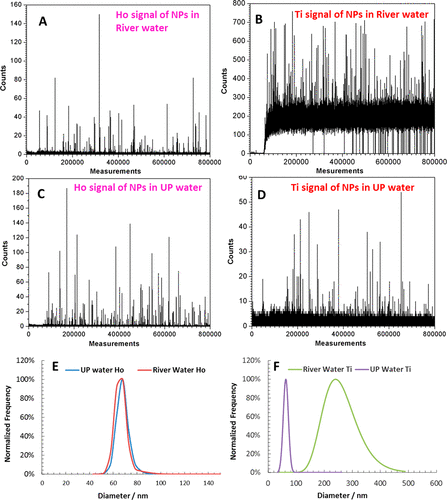NanoFASE Case study: Ho-TiO2 core-shell design; detection in river water
spICP-MS was recently adopted as a means to detect NPs at ultra low concentration as its detection limit is in the ng/L range. However, spICP-MS fails to differentiate between engineered ENMs composed of high-abundance elements (such as titanium) and their natural counterparts. To ensure that only engineered TiO2 ENMs are identified in complex media and the environmental compartments of interest to NanoFASE, Ho core–TiO2 shell (NaHoF4@TiO2) ENMs were synthesized with the low-abundance element Holmium used as a chemical marker.
The core–shell design was proposed to achieve a high dopant concentration for better detection while retaining the structural integrity of the ENMs being investigated via the shell. The resulting ENMs consisted of a 60 nm NaHoF4 core and a 5 nm anatase TiO2 shell, as determined by TEM, STEM-EDX mapping, and spICP-MS.
NanoFASE partner University of Birmingham demonstrated that these core–shell NaHoF4@TiO2 ENMs remain detectable by spICP-MS in the presence of a high background of Ti despite the ENMs being present at an extremely low concentration. The NPs exhibited excellent detectability by spICP-MS at concentrations down to 1 × 10-3 ng/L even in complex natural environments with high Ti background, such as river water from Birmingham.

The figure presents spICP-MS results relative to NaHoF4@TiO2 core-shell ENM dispersions in ultrapure (UP) water and river water. (A) Real-time Ho signal from NaHoF4@TiO2 suspension in river water; (B) real-time Ti signal from NaHoF4@TiO2 suspension in river water; (C) real-time Ho signal from NaHoF4@TiO2 suspension in ultrapure water; (D) real-time Ti signal from NaHoF4@TiO2 suspension in ultrapure water; (E) size distribution of NaHoF4 component detected by spICP-MS; and (F) size distribution of TiO2 component detected by spICP-MS. Stock suspensions of ENMs were diluted 100 million times with ultrapure water and river water, respectively, from ca. 1.5 mg/mL to ca. 15 ng/L for spICP-MS measurements. River water was collected from the Worcester and Birmingham Canal, near the University of Birmingham, and was used without filtration. From: Cui et al., 2019.
Read more |
|
Cui X, Fryer B, Zhou D, Lodge R, Khlobystov A, Valsami-Jones E, Lynch I (2019) Core-shell NaHoF4@TiO2 NPs: A labelling method to trace engineered nanomaterials of ubiquitous elements in the environment. ACS Applied Materials & Interfaces, 2019, 11, 19452-19461. https://pubs.acs.org/doi/10.1021/acsami.9b03062 |
Contact
 Xianjin Cui
Xianjin Cui

Benjamin Fryer

Iseult Lynch
